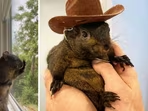The bird flu has killed a polar bear for the first time ever – and experts say it likely won't be the last
Rampant avian flu that has impacted millions of poultry birds and thousands of wild birds in the U.S. alone has now killed a polar bear for the first time ever recorded. The Alaska population of the bear is already classified as threatened, and experts believe that the new source of mortality could make the species' survival more difficult.
The infected polar bear died sometime in the fall, and the cause of death was confirmed to have been the avian flu on Dec. 6, according to Alaska's Division of Environmental Health. Prior to that, the viral strain had killed a few red foxes, one black bear and one brown bear in Alaska, according to a June 2023 report from the state.
"This is the first polar bear case reported, for anywhere," state veterinarian Dr. Robert Gerlach told the Alaska Beacon, saying that it was likely the bear had eaten a dead bird when it contracted the virus. The bear's body was found in the North Slope, where state data shows more than a dozen animals have tested positive since the outbreak began in 2022.
Polar bears, the largest living bear species, are considered threatened by the U.S. Fish and Wildlife Service. The animals primarily feed on seals, but global warming has contributed to a loss of sea ice in the Arctic that seals rely on. Research has shown that the condition of some seal species has declined because of it.
Right now, it's not clear just how much polar bears are relying on birds as a food source, or how many polar bears could be infected. But Douglas Clark, an associate environmental professor at the University of Saskatchewan, told CBS News that it's "absolutely typical" for polar bears to feast on birds, both alive and dead, and that reliance on this food source "appears to be increasing in multiple portions of the Arctic as it warms."
"Earlier sea ice breakup puts the bears onshore earlier in the season (on average) and increases their overlap with nesting birds," he said. "That means the risk of avian influenza infection for polar bears is probably also going up over time."
Clark told CBS News that disease "has never been considered a conservation concern for polar bears," making this case, "a novel situation."
"This is unlikely to be an isolated event," he told Live Science. "It's just that this one led to an outcome that was detected."
For now, Clark told CBS News, "nobody knows" what kind of impact this will have for the polar bears of the Arctic.
"There are 19 populations of polar bears around the Arctic, and they all face different environmental conditions, overlapping with different bird populations too, so their exposure to avian flu is likely to vary," he said. "The impact will probably vary too because those populations are all experiencing climate warming at different rates and in different ways, and dealing with two big challenges is tougher than just one."
Gerlach told Live Science that if more polar bears end up impacted by the virus, it could spell trouble for maintaining their population.
"Decreasing the population of animals will mean fewer for breeding and raising the next generation," he said. "This on top of the stressors for access to habitat, food sources and impact of climate change could have some devastating effects."
And treating the flu among polar bears isn't really an option. Currently, it's "extremely difficult and costly" to diagnose and treat polar bears infected by the avian flu, Clark said.
"This particular avian flu outbreak is of global scope," Clark told CBS News. "It has affected many species of birds and mammals worldwide: that scope is unprecedented. Each of those interactions with a new host species creates novel conditions for the virus, and in 2020 we all learned what that can mean."
The most recent avian flu outbreak has caused trouble worldwide. In its most recent situation report, published in October, the World Organization for Animal Health said that more than half a million poultry birds died or were culled globally in the most recent three-week period leading up to the report. In Argentina, 300 southern elephant seals died because of the virus.
"The virus has been increasingly detected in mammals in recent months, a situation that should be monitored," the group said. "... Experts highlighted that the negative impact of HPAI (Highly Pathogenic Avian Influenza) on Antarctic wild birds and mammal populations could be immense. ... It is very worrying to see that the disease has progressed in this direction over the last few weeks."
- In:
- Climate Change
- Endangered Species
- Bird Flu
- Polar Bear
- Avian Flu
- Alaska
- Avian Influenza

Li Cohen is a social media producer and trending content writer for CBS News.
Disclaimer: The copyright of this article belongs to the original author. Reposting this article is solely for the purpose of information dissemination and does not constitute any investment advice. If there is any infringement, please contact us immediately. We will make corrections or deletions as necessary. Thank you.
Title:The bird flu has killed a polar bear for the first time ever – and experts say it likely won't be the last
Url:https://www.investsfocus.com









